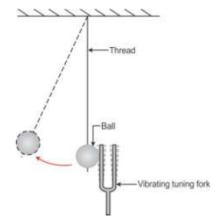ICSE Revision Notes for Propagation of Sound Class 9 Physics
Chapter Name | Propagation of Sound |
Topics Covered |
|
Related Study |
Production of Sound
- When you strike a tuning fork, it starts vibrating. When this tuning fork is brought near the ear, we hear some sound.
- When this fork is brought near a hanging ball, the ball starts oscillating.
- Thus, a vibrating source is necessary for the production of sound.
Sound Needs a Material Medium to Travel
- Sound is a mechanical wave and needs a material medium to propagate. It cannot travel through vacuum.
- The medium through which sound travels must have the following properties:
1. It should be elastic so that its particles return to their initial positions after displacement.
2. It should have inertia so that its particles have the capacity to store energy.
3. It should be frictionless so that there is no loss of energy in propagation of sound through it.
Experiment to test the requirement of material medium
- The hammer strikes the gong of the bell and sound is heard when the switch is pressed, that is, when the circuit is complete.
- If air is present inside the jar, then we are able to hear the sound. However, if air is removed, then the sound is not audible.
- The hammer is seen striking the gong, but the sound is not heard.
Propagation of Sound in a Medium
- The matter or substance through which sound is transmitted is called a medium.
- When an object vibrates, the particles in the surrounding medium vibrate. These particles send the vibrations to adjacent particles and energy continues to transmit until it reaches our ears.
- The wave in which the particles of the medium vibrate about their mean position in the direction perpendicular to the direction of the propagation of waves is called a transverse wave.
- A transverse wave is composed of alternate crests and troughs.
Characteristics of Wave Motion
- A wave is produced by periodic disturbance at a point in the medium.
- Due to the propagation of a wave in a medium, the particles of the medium vibrate about their mean positions, and energy is transferred from one place to another in the medium with a constant speed.
Sound Waves are Longitudinal Waves
- Sound propagates in a medium as a series of compressions and rarefactions.
- A longitudinal wave is a wave where the individual particles vibrate parallel to the direction of the propagation of the wave.
- Sound waves also propagate in the same manner, and hence, they are longitudinal waves.
- A longitudinal wave is composed of alternate compressions and rarefactions.
Terms Related to Wave Motion
- Amplitude: The maximum displacement of a particle of a medium on either side of the mean position is called the amplitude of a wave.
- Time period: The time taken by the particle of a medium to complete one vibration is called the time period of the wave.
- Frequency: The number of oscillations made by the particle of the medium per unit time is called the frequency of the wave.
- Wavelength: The distance travelled by a wave in one time period of a vibration of a particle of a medium is called the wavelength of the wave.
- Wave velocity: The distance travelled by a wave in one second is called wave velocity. It is denoted as ‘V’.
Relation between wavelength, wave velocity and frequency
V = νλ
Speed of Sound in Different Media
The speed of sound in a medium depends on the following two factors:
- Elasticity E of the medium
- Density ρ of the medium
The speed of sound in a medium is given as
- Newton derived the above formula assuming that the temperature of a gas in which sound travels does not change. Hence, the above equation should contain isothermal elasticity which is equal to pressure.
- Laplace corrected this formula considering an adiabatic change. For an adiabatic change, the modulus of elasticity is E = γP, where γ is the ratio of specific heat at constant pressure to the specific heat at constant volume.
Factors Affecting the Speed of Sound in a Gas
- Speed of sound is inversely proportional to the square root of density of the gas.

- Speed is directly proportional to the square root of temperature V ∝ √T. Here, T is measured in Kelvin.
- The speed of sound increases by 0.61 m s−1 for every degree rise in temperature.
V = V0 + 0.61t - The speed of sound in air increases with increase in humidity.
- If wind is blowing in the direction of propagation of sound, then the speed of sound increases. However, if wind direction is opposite to the direction of propagation of sound, then the speed of sound decreases.
- The Speed of Sound is Independent of the Following Factors:
1. Pressure
2. Amplitude
3. Wavelength (or frequency)
Comparison of Speed of Sound and Speed of Light
|
Speed of Sound |
Speed of light |
|
It is 330ms-1 at 0°C in air. |
It is 3×108 ms-1 in air i.e. it is a million times more than the speed of sound. |
|
The speed of sound is more in solids, less in liquids and least in gases. |
The speed of light decreases in denser media. Thus, it is highest in gases and least in solids. |
|
Sound requires a material medium i.e. it cannot travel in vacuum. |
Light can travel in vacuum. In fact, light travels fastest in vacuum. |
Range of Hearing
- The audible range of sound for human beings extends from 20 Hz to 20000 Hz.
- Sound of frequency less than 20 Hz is called infrasonic sound, whereas sound of frequency higher than 20 kHz is called ultrasonic sound.
Ultrasound and its Applications
- Ultrasounds are high-frequency waves. These waves are able to travel along well-defined paths even in the presence of obstacles.
- Ultrasounds are able to travel freely in solids and liquids, but in gases, their intensity reduces considerably.
Properties of Ultrasound
Properties of ultrasound are similar to ordinary sound, but due to high frequencies, they also have the following properties:
- The energy carried by ultrasound is very high.
- It can travel along a well-defined straight path. It does not bend much along the edges of an obstacle as it has very small wavelength.
Applications of Ultrasound
- Ultrasound is generally used to clean parts located in hard-to-reach places.
- Ultrasounds can be used to detect cracks and flaws in metal blocks.
- Ultrasonic waves are made to reflect from various parts of the heart and form the image of the heart. This technique is called Echocardiography.
- Ultrasonography is used to obtain images of patient’s organs such as the liver and kidneys. It helps to detect stones in the kidneys.
- Ultrasound can be used to remove cataract and to break stones in the kidneys into fine grains.
- SONAR (SOund NAvigation and Ranging) uses ultrasound to detect and find the distance of objects under water.






